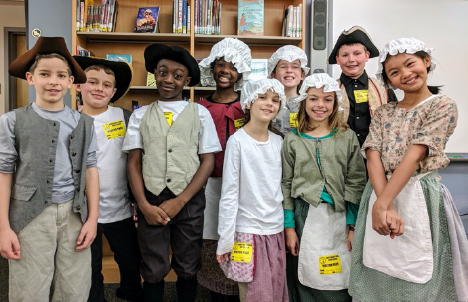In 2018, students from the Class of 2026 worked together to answer the driving question, “If there were enslaved people at Potowomut in the past, how can we raise awareness and honor them by giving them a voice?” Working with several outside organizations including The Office of Secretary of State, Rhode Island State Archives, and Rhode Island Slave History (RISH), the “Junior Historians” went to work. After many months of researching, the students were able to verify that there was evidence of slavery on Potowomut.
Working with Charles Roberts, RISH Founder and Director, the students proposed that a medallion be placed on the school’s campus. Diane Rich, Head of School, approved the proposal. On May 7th, 2022 the work of many committed students, teachers, and administrators was made tangible by the installation of the Rhode Island Slave History Medallion on the Rocky Hill Country Day School’s grounds.
History of the Greene Family of Rhode Island, 1600-1800
• 1642, John Greene bought Occupassuatuxet. This land remained in his family for 140 years
• 1643 buys Shawomet, which later became the Warwick settlement
• Major John Greene: Deputy Governor 1690-1700 Helped build Post Road and Post Service
• Governor William Greene (1743-1758) ,
• Governor William Greene Jr. (1778 86)
• Major General Nathanael Greene, Rhode Island’s most important Revolutionary War hero
• Colonel Christopher Greene, hero of Revolution
• General George Sears Greene-Fought in Civil War
Evidence of Greene Family and Slavery 1600-1800
• James Greene used slave labor to build forge at what is now Forge Road.
• At least 8 enslaved people living in Greene homes (From 1790-1850-From census)
• “Richard of Potowomut grandaughter Lydia Brown Lebaron says “servants both white and colored were numerous.” (At Rocky Hill Property)”
• “Elizabeth Greene of Warwick Nov 20th 1781 bill of sale for three year old Nat to Elizabeth’s son, Thomas
Greene.”
• “Greene agrees to indenture Sarah born in his house of his Indian servant Marcy as a servant or apprentice.”
• John Greene of Warwick: accounts with name prince ” my john ” and ” my negro. ”
• 1774 Rhode Island Census
o GREENE, William, Esq. 4 “blacks”
o GREENE, Richard, 2 “blacks”
o GREENE, Chris, 1 “black”
o GREENE, James Esq 1 “blacks”
o GREENE, Phillip, Esq. 9 “blacks”
o GREENE, Benjamin, 6 “blacks”
o GREENE, Mary Widow, 6 “blacks”
o GREENE, Thomas, Capt. 1 “black”
o GREENE, Daniel, 4 “blacks”
o GREENE, Godfrey, 1 “black”
o GREENE, Paul, 1 “black”
o GREENE, Ames, 1 “blacks
o GREENE, Christopher, 3 “black”
o GREENE, Love Fones, 3 “natives”
• Warwick, Rhode Island on July 28, 1725, Hager, a “negro” slave, was willed 10 shillings and her children were bequeathed 5 shillings each by Captain Peter Green.
• Voyage of the ship, “Hope” owned by Capt. William C. Greene. 109 slaves from Gold Coast to South Carolina
• Ship “Success,” Owner William Greene: Bought at least one slave in Africa – fate unknown
• Slaves enlisted in Continental Battalions
o Cuff Greene-Owner James Greene, Son of William
o Pero and Jack Greene-Owner Philip Greene Esq.
o Cato Greene-His Excellency William Greene
History of Slavery in Rhode Island 1600’s-1800’s
• 1600’s Slavery in America began with indentured servants.
• 1652 Black slaves were in Rhode Island.
• 1676 As a direct outcome of the King Philip’s War (1675-1676), surviving Natives are enslaved in Rhode Island.
• 1700s As early as 1708, slaves
outnumbered white indentured servants in the colony almost 8 to 1.
• 204 different Rhode Island citizens owned a share or more in a slave voyage at one time or another.
• Slave trade number one important financial activity in Ri the triangle trade
• Rhode Islanders made rum that they traded for slaves in Africa. Trade the slaves to southern colonies for sugar to make more rum.
• Rhode Island was among the most active Northern colonies in importing slaves.
• Rhode Island’s black population tripled from 1715 to 1730, and almost tripled again by 1755.
• In February 1784 there was a law made that children of slavery would become apprentices and if you were a girl you would be free at 18 a boy at 21.
• Slavery ended in 1865
History of Potowomut and Hopelands, 1600’s-Present
• Narragansett tribes uses Potowomut as a gathering place
• 1654, the Potowomut peninsula was purchased from Taxmann for grazing of the settlers livestock
• 1680 James Greene settles at what came to be known as Greene’s River.
• James’s son, Jabez, built a dam and a mill. Later his descendants established an anchor forge. The Greene family mainly used the land to raise cattle and harvest hay, which was then shipped across Greenwich Bay to the wharf in Apponaug, Rhode Island
• 1686 Thomas Greene builds first house which becomes part of Hopelands
• 1699 Thomas Greene drowns. John Greene (8 y/o) inherits the house.
• 1757 “King” Richard Greene inherits the house (dies in 1779 also OWES other people :money including The Brown Family)
• 1779-1792 the Browns take ownership Hopelands
• 1792 Nicolas Brown gives the land to Hope Brown Ives as a wedding gift
• 1835 Thomas Poynton Ives Dies
• 1855 Hope Brown Ives dies and Charlotte Rhoda Ives Goddard inherits the house (daughter of Hope)
• 1881 Moses Ives Brown Goddard inherits the house
• 1924 Charlotte’s granddaughter Charlotte Ives Brown Goddard Shaw inherits the house and buys all the land around it
• 1948 The land was sold to Rocky Hill Country Day School and Rocky Hill School was founded in 1934 By Dorothy Marshall
Resources
• Guide to Manuscripts at the Rhode Island Historical Society Relating to People of Color
• Trans Atlantic Slave Trade Database
• Census of the Inhabitants of the Colony of Rhode Island and Providence Plantations : John Russell Bartlett
• THE 1ST RHODE ISLAND REGIMENT AND REVOLUTIONARY AMERICA’S LOST OPPORTUNITY

